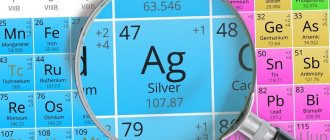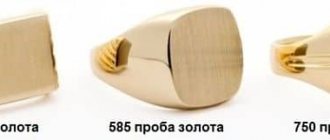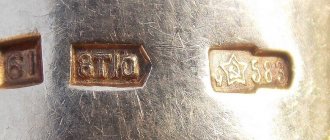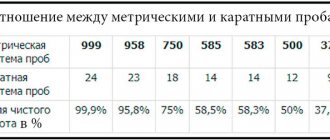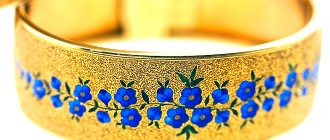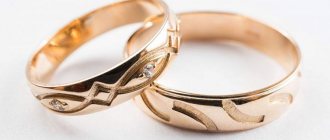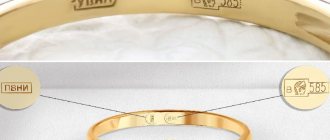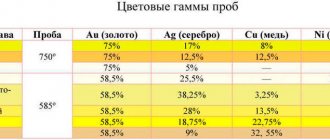Post updated: May 26, 2020
There is no such person who has not seen yellow metal in his entire life. There are several minerals found in nature that are similar in appearance to the yellow metal. But as they say: “all that glitters is not gold.” In order not to confuse the precious metal with other materials, you need to know the density of gold.
Density of noble metal
Molecular structure of gold.
One of the important characteristics of a precious metal is its density. The density of gold is measured in kg m3.
Specific gravity is a very significant characteristic for gold. This is usually not taken into account, since jewelry: rings, earrings, pendants have very little weight. But if you hold a kilogram ingot of real yellow metal in your hands, you can see that it is very heavy. The significant density of gold makes it easier to mine. Thus, washing at sluices ensures a high level of gold recovery from washed rocks.
The density of gold is 19.3 grams per cubic centimeter.
This means that if you take a certain volume of precious metal, it will weigh almost 20 times more than the same volume of plain water. A two-liter plastic bottle of golden sand weighs about 32 kg. From 500 grams of precious metal you can lay out a cube with a side of 18.85 mm.
Table of density of gold of various samples and colors.
The density of the original gold is several units lower than that of the already purified metal and can vary from 18 to 18.5 grams per cubic centimeter.
583 gold is less dense, as this alloy consists of different metals.
At home, you can determine the density of gold yourself. To do this, you need to weigh the precious metal product on ordinary scales, in which the division value must be at least 1 gram. After this, a container with a volume marking must be filled with liquid, in this case water, into which the decoration should be lowered. Care must be taken to ensure that the liquid does not overflow.
After this, we measure how much the volume of liquid has changed after lowering the gold item into the container. Using a special formula, known from school, we calculate density: mass divided by volume.
It must be remembered that a precious metal product is not made of pure gold, so it is necessary to make an adjustment for the density of the alloy sample.
Indicators of the specific gravity of other metals
Specific gravity is an indicator that is an integral characteristic of other metals.
The specific gravity of silver is affected by the fineness of the alloy. When other metals (copper, nickel) are added to it, the specific gravity and density are lost. Thus, the density of copper is 8.93 g/cm3, nickel – 8.91 g/cm3. All values are calculated using formulas.
You may be interested in: How is gold formed and how does it appear on the planet?
Silver is the same noble metal as gold. Its specific gravity is 10.5 g/cm3. It melts at a temperature of 960 degrees. The main physical characteristics of silver are:
- corrosion resistance;
- low resistance;
- increased light reflectivity.
Despite its natural softness, silver has a high density and specific gravity.
Titanium is a non-ferrous metal of a white-silver hue. It has high strength, although it is light in weight. So, it is 12 times stronger than aluminum and 4 times stronger than copper and iron. In terms of the degree of presence in the earth's crust, titanium is given fourth place among the rest.
The low specific gravity of titanium - 4.505 g/cm3 is more consistent with alkali metals. An oxide film forms on its surface, which prevents the formation of corrosion.
Zinc is also a non-ferrous metal with a white-bluish tint. It has medium hardness and an initial melting point of 419 degrees. Under the influence of a temperature of 913 degrees, this metal acquires a vaporous state. Zinc has a specific gravity of 7.13 g/cm3.
Normal temperature makes zinc brittle, but increasing it to 100 degrees makes the metal flexible and ductile. When interacting with air, an oxide film forms on the surface of zinc.
The color of lead is dirty gray, but this does not affect the natural shine of the metal. However, the glow stops quite quickly due to the formation of an oxide film on the surface of the lead. The lead alloy has a high specific gravity - 11.337 g/cm3. In this indicator, it exceeds zinc, aluminum, iron and some other metals. Despite its high density, lead is a very soft metal.
It is easy to knead in your hands or scratch with your nails. For lead, a temperature of 327.5 degrees is enough for it to begin to melt.
The table shows the specific gravity and melting points of other metals.
You may be interested in: What is the highest purity of white gold?
| Name of metal | Melting point, °C | Specific gravity, g/cc |
| Zinc | 419.5 | 7.13 |
| Aluminum | 659 | 2.69808 |
| Lead | 327.4 | 11.337 |
| Tin | 231.9 | 7.29 |
| Copper | 1083 | 8.96 |
| Titanium | 1668 | 4.505 |
| Nickel | 1455 | 8.91 |
| Magnesium | 650 | 1.74 |
| Vanadium | 1900 | 6.11 |
| Tungsten | 3422 | 19.3 |
| Chromium | 1765 | 7.19 |
| Molybdenum | 2622 | 10.22 |
| Silver | 1000 | 10.5 |
| Tantalum | 3269 | 16.65 |
| Iron | 1535 | 7.85 |
| Gold | 1095 | 19.32 |
| Platinum | 1760 | 21.45 |
How to distinguish real yellow metal from a fake
At the moment, there is a very large percentage of counterfeit gold on both the Russian and foreign markets. There is a huge risk of purchasing gold jewelry containing up to 5% of the precious metal or without it at all. Basic rules when buying gold will help you avoid feeling deceived.
First, you should take a good look at the product. There must be a sample on it. Moreover, it should not consist of crooked numbers or blurry marks. Otherwise, this is the first sign of a counterfeit.
A sample of a unified state hallmark for gold products.
The next sign of a fake is the reverse side of the precious metal jewelry. It must be as well made as the front side, otherwise it is a low-quality product. It is also possible to determine the quality of a product using a characteristic such as gold density, but it is impossible to conduct such an experiment in a store.
There is also a way to determine it, called a strength test. True, it is not always possible to scratch a gold item in front of the seller, so this method cannot be implemented.
Iodine test.
The following chemical methods can serve as good ways to determine the quality of a product. You can drop a little iodine on the yellow metal jewelry. If the speck is dark in color, then we can speak with confidence about the quality of the product being offered. Table vinegar can also help. If, after three minutes spent in it, the precious metal has darkened, then you can safely take the product to a landfill.
Gold chloride can be a great help in determining quality. From the chemistry course, it became known not only the density of gold, but also the fact that it cannot enter into any chemical reactions. Therefore, if after applying gold chloride to a precious metal it begins to deteriorate, then this is a real fake and should belong in the trash.
One of the best ways to protect yourself from purchasing counterfeit goods is to purchase precious metal products in well-known specialized stores.
In this case, there is a high probability of purchasing a truly high-quality product. Even though their price is a little higher than in various shops and markets, the quality is worth it. Otherwise, you can purchase a counterfeit product and very much regret the money saved.
Hydrostatic method: determining a sample of a precious alloy
Institutions specializing in receiving gold products use many different methods to determine and confirm the sample of brought gold. Based on the knowledge that gold is a heavy metal with high density, the hydrostatic method was introduced.
It is based on determining the difference in weight when measuring parameters in the open air, under normal conditions, and in a liquid with a certainly known density.
Let’s make a reservation right away: this method of testing gold is only suitable for complete products, without stones or other inserts made from other materials. It is also impossible to obtain adequate data on hollow products consisting of many moving parts.
To carry out hydrostatic weighing of a gold item, you will need a jewelry scale, a measuring cup (or any other transparent one), fishing line or thin thread. Distilled water is usually used as a liquid of known density. First, the gold product is weighed using the usual method, and the data is recorded. Then a glass of water filled more than half is placed on the scales, the scale readings are reset to zero (the scales must have a function for resetting the tare weight). Our gold product, suspended on a fishing line, is completely lowered into the water, without touching the bottom and walls of the glass. The scale data is also recorded.
For density analysis, it is better to use a hydrostatic calculator, since manual calculations will take much longer and are not as accurate.
Gemini of gold
There are several metals found in nature that have the same density as gold. These are uranium, which is radioactive, and tungsten. It is cheaper than the yellow metal, but the density of tungsten and gold is almost the same, the difference is three tenths. What distinguishes tungsten from gold is that it has a different color and is much harder than the yellow metal. Pure gold is very soft and can be easily scratched with a fingernail.
A fake gold bar filled with tungsten on the inside.
The fact that the density of elements such as tungsten and gold is the same is very attractive to counterfeiters. They replace gold bars with tungsten of similar density and weight, and cover the top with a thin layer of precious metal. At the same time, the high cost of the yellow metal makes tungsten more popular among young people. Tungsten products are much cheaper and more scratch resistant.
Properties of metal alloys and their applications
Gold is rarely found in its pure form. The natural alloy of gold and silver found in nature is called electrum. More often, when extracting a noble chemical element, it is necessary to purify the metal from impurities of palladium, copper and silver using different methods provided for by the technological process. The density of gold changes when heated, but its malleability and softness are retained under natural conditions.
- The yellow alloy goes well with emeralds, rubies, sapphires, and white gold with diamonds. The main consumer of this noble material is the jewelry industry. It is this industry that specializes in the use of various alloys of gold with copper, aluminum, silver, steel and other alloy additives.
- By changing the density and physical properties of the noble material, using technologies for preparing and processing alloys, jewelry industry masters create unique compositions.
- In industrial production, gold is used to form a special type of glass used in rocket science. Alloys based on a noble chemical element are used for soldering contacts in ultra-precision devices and technical instruments.
- The properties of a noble chemical element that are not exposed to the external environment are used in the creation of alloys for the production of equipment and communications (pipes).
Gold is widely used not only in jewelry
The practical use of gold is closely related to its physical and chemical properties.
Lead Density
The purer the gold, the less hard it is, so in the past the yellow metal was bitten to test. This method is unreliable. The jewelry can be made of lead, covered with a very thin layer of gold. Lead also has a soft structure. You can try to scratch the jewelry from the wrong side, and underneath a very thin layer of precious metal you may find base metal.
The density of the element of the periodic table - lead and its brother - gold is different. The density of lead is much less than gold and is 11.34 grams per cubic centimeter. Thus, if we take the yellow metal and lead of the same volume, then the mass of gold will be much greater than that of lead.
White gold is an alloy of yellow precious metal with platinum or other metals that give it a white, or rather matte silver, color. There is an opinion in everyday life that “white gold” is one of the names for platinum, but this is not so. This type of gold costs a little more than usual. In appearance, the white metal is similar to silver, which is much cheaper. The density of such elements of the periodic table as gold and silver is different. How to distinguish white gold from silver? These precious metals have different densities.
Silver is the least dense material of all those discussed in the article.
The density of gold is greater than that of silver. Its density is 10.49 grams per cubic centimeter. Silver is much softer than white metal. Therefore, if you run a silver item across a white sheet, a mark will remain. If you do the same with white precious metal, there will be no trace.
Determination of carat weight
British carats are a traditional value used to measure the purity of gold and its weight in a product. The smallest value is 8 carats (K). The specific gravity of 999 gold is 24 carats. If other elements are added to the alloy to change the characteristics of the metal, the carat value drops. The 18-karat precious metal contains 6 parts of impurities and 18 parts of pure gold.
For example, high-grade 917 gold has a mass of 22 carats. And such a popular 585 alloy is only 14 carats.
conclusions
So, in our article we looked at the density of gold - a precious metal that each of us has encountered in life and will still encounter. The data presented can be summarized as follows: the density of the most popular gold standard, 585, is 12.5-14 g/cm3, for other alloys it is lower or higher, respectively.
Based on the density of the gold alloy, the sample can be determined, which is an indicator of the pure gold content in the alloy. These methods are used in institutions that accept gold.
We hope our article was informative and gave you a few exciting minutes. Let there be only real high-grade gold in your box!
ORIGIN
Gold products
Native gold is the main form of gold found in nature. It is concentrated in hydrothermal deposits forming gold ores, unevenly distributed in fractured vein quartz and in sulfides - pyrite, arsenopyrite, pyrrhotite, etc. In essentially sulfide ores, native gold is finely dispersed. During the oxidation of ores on the earth's surface, fine native gold is partially dissolved and redeposited; in some cases it enriches the upper parts of ore bodies. The processes of their destruction lead to the release of particles of native gold and their accumulation in placers; moving with water flows together with other plastic material, the particles become rounded, rounded, deformed, and partially recrystallized; As a result of electrochemical corrosion, a thin shell of high-fine gold is formed on them, which leads to a general increase in the standard of native gold in placers.

